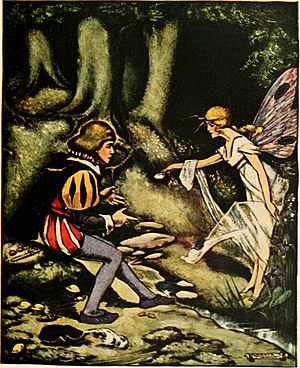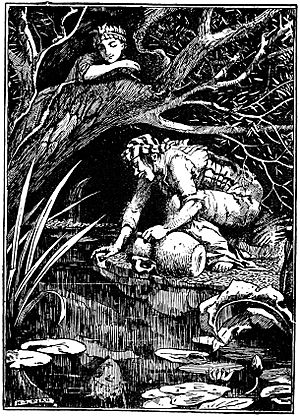The Love for Three Oranges (fairy tale) facts for kids
Quick facts for kids The Love for Three Oranges |
|
|---|---|

The prince releases the fairy woman from the fruit. Illustration by Edward G. McCandlish for Édouard René de Laboulaye's Fairy Book (1920).
|
|
| Folk tale | |
| Name | The Love for Three Oranges |
| Also known as | The Three Citrons |
| Data | |
| Aarne–Thompson grouping | ATU 408 (The Three Oranges) |
| Region | Italy |
| Published in | Pentamerone, by Giambattista Basile |
| Related | The Enchanted Canary Lovely Ilonka |
"The Love for Three Oranges" or "The Three Citrons" is an old Italian fairy tale. It was written by Giambattista Basile in his book Pentamerone. This story is special because the main character in the book's frame story uses it to show that someone else has taken her place.
Contents
The Story of the Three Oranges
Once, there was a king who had only one son, a prince. The king really wanted his son to get married. One day, the prince accidentally cut his finger. A drop of his blood fell onto some white cheese. The prince then decided he would only marry a woman who was as white as the cheese and as red as the blood. So, he left home to find her.
The prince traveled far and wide. He reached an island where Ogresses lived. Two old women there told him he could find what he was looking for if he kept going. A third old woman gave him three Citrons (a type of fruit like a lemon). She warned him not to cut them open until he was near a fountain. She said a fairy would fly out of each fruit, and he would need to give her water right away.
The prince returned home and went to a fountain. He was not quick enough to give water to the first two fairies who came out of the fruits, and they disappeared. But he was fast enough for the third one! This woman was as red as blood and as white as cheese. The prince wanted to take her home properly, with nice clothes and servants. He asked her to hide in a tree while he went to get things ready.
A black slave came to the fountain to get water. She saw the fairy woman's reflection in the water. She thought the reflection was her own and believed she was too beautiful to do chores. She refused to get water, and her mistress beat her. The slave ran away. The fairy woman in the tree laughed at her. The slave looked up and saw the fairy. She asked the fairy what happened. When she heard the story, the slave offered to help the fairy fix her hair for the prince. When the fairy agreed, the slave stuck a pin into her head. The fairy quickly escaped by turning into a bird. When the prince came back, the slave lied. She said that evil magic had changed her into an ugly person.

The prince and his parents got ready for the wedding with the slave. Meanwhile, the bird (who was the real fairy) flew to the kitchen. It asked about the food being cooked. The cook was told to catch and cook the bird. The cook did, but threw the water used to scald the bird into the garden. Three days later, a citron tree grew there. The prince saw the citrons and took them to his room. He opened them just like he did the first three, and his true bride appeared! She told him everything that had happened.
The prince then held a big feast. He asked everyone what should happen to someone who would harm his bride. Many people said different things. The slave said such a person should be burned. So, the prince had the slave burned for her evil actions.
Different Versions of the Story
This story, "The Love for Three Oranges," is a very old type of tale. It's known as Aarne-Thompson type 408. The Italian version is thought to be the first one. Later, other versions appeared in places like France. For example, in a French version, the girls are trapped inside apples instead of oranges.
Many similar fairy tales exist. Sometimes, stories like "The Black and the White Bride" or "The Search for the Lost Husband" mix parts of this tale into their own plots.
Where the Story is Told
This fairy tale is very common in Southern Europe. You can find many versions in Italy, Greece, Spain, and Portugal. It also appears in Austria, Ukraine, and Japan.
Italy
Italy has the most versions of this story. There are over fifty different Italian tales like it! Sometimes the fruit is a Pomegranate, a Lemon, or a bitter orange.
In one Italian story from Sicily, a prince is cursed to find "the beauty with seven veils." He finds three maidens hidden in chests. He releases one, but leaves her by a tree. He forgets her for a year. When he returns, she has turned into a dove. This version is a bit different because the maiden doesn't come out of a fruit.
Hungary
The story is very popular in Hungary, with many different versions. Often, the fairy maiden comes out of a plant.
In one Hungarian tale called The Reed Maiden, a prince wants to marry "the most lovely maiden." He learns she is hidden in three reeds. He releases her and marries her, but a gypsy replaces her.
Another Hungarian story, Lovely Ilonka, has the prince looking for a beautiful maiden. An old woman tells him to break three bulrushes near water.
In The Maiden in the Woods, a prince cuts a perennial plant and a maiden appears. He gives her water and marries her. She has twins, but an evil queen replaces them with puppies. The babies are saved by woodpeckers.
The Fairy from Three-Branched Oak Tree tells of a king who breaks branches from a magical oak tree. Maidens appear and ask for water. He saves the third one and marries her. A witch tricks the maiden, throws her into a well, and replaces her with her own daughter. The maiden turns into a fish.
In The Princess from the Tree Branch, a prince breaks three tree branches. A maiden appears. A gypsy woman throws her into a well, where she becomes a goldfish.
In The Daughter of the Griffin Bird, a prince finds five Griffin eggs. A girl comes out of each. He saves the last one by giving her water. A gypsy girl replaces her, and the maiden becomes a goldfish and then a tree.
In a Hungarian-Slovenian tale, The Three Lemons, the prince finds three lemons on a glass hill. Maidens come out and ask for food and clothes. He saves the third, but a gypsy maidservant sticks a golden pin in her hair, turning her into a dove.
Greece
In a Greek version from Asia Minor, the false bride pushes the fruit maiden into water, and she turns into a fish. The false bride insists on eating the fish. Three drops of blood fall from the gutted fish, and a cypress tree grows. A splinter from the cypress tree gets stuck in an old lady's apron. The maiden then appears from the splinter and helps the old woman.
Asia
This tale is also very popular in Eastern countries. It's one of the most common tales in Arab stories, even though it's not in The Arabian Nights. Some experts think the story might have started in the Levant (a region in the Middle East).
A Persian version is called The Three Silver Citrons. Another Persian tale, The Orange and Citron Princess, is different because it only has one princess, not three.
A Turkish version is called The Three Orange-Peris. In an Indian story, The Anar Pari, or Pomegranate Fairy, the princess from the fruit dies many times because of the false bride. But she always comes back to life and gets her original body.
Other Indian tales, like The Bél-Princess, are similar. They are about a beautiful princess hidden in a fruit who is replaced by a false bride.

